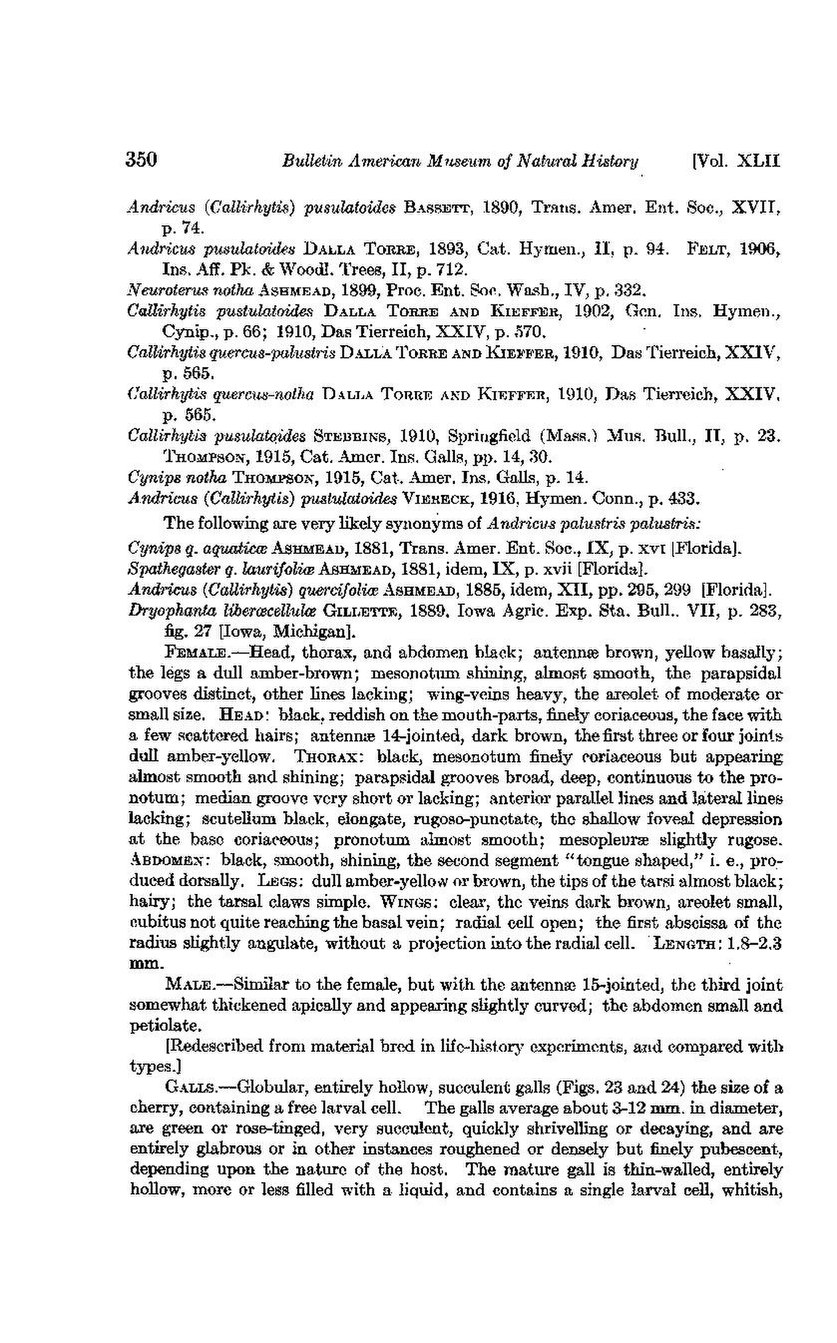Andricus (Callirhytis) pusulatoides Bassett, 1890, Trans. Amer. Ent. Soc., XVII, p. 74.
Andricus pusulatoides Dalla Torre, 1893, Cat. Hymen., II, p. 94. FELT, 1906, Ins. Aff. Pk. & Woodl. Trees, II, p. 712.
Neuroterus notha Ashmead, 1899, Proc. Ent. Soc. Wash., IV, p. 332.
Callirhytis pustulatoides Dalla Torre and Kieffer, 1902, Gen. Ins. Hymen., Cynip., p. 66; 1910, Das Tierreich, XXIV, p. 570.
Callirhytis quercus-palustris Dalla Torre and Kieffer, 1910, Das Tierreich, XXIV, p. 565.
Callirhytis quercus-notha Dalla Torre and Kieffer, 1910, Das Tierreich, XXIV, p. 565.
Callirhytis pusulatoides Stebbins, 1910, Springfield (Mass.) Mus. Bull., II, p. 23. Thompson, 1915, Cat. Amer. Ins. Galls, pp. 14, 30.
Cynips notha Thompson, 1915, Cat.. Amer. Ins. Galls, p. 14.
Andricus (Callirhytis) pustulatoides Viereck, 1916, Hymen. Conn., p. 433.
The following are very likely synonyms of Andricus palustris palustris:
Cynips q. aquatica Ashmead, 1881, Trans. Amer. Ent. Soc., IX, p. xvi [Florida].
Spathegaster q. laurifoliæ Ashmead, 1881, idem, IX, p. xvii [Florida].
Andricus (Callirhytis) quercifolim Ashmead, 1885, idem, XII, pp. 295, 299 [Florida].
Dryophanta liberacellulæ Gilette, 1889, Iowa Agric. Exp. Sta. Bull.. VII, p. 283, fig. 27 [Iowa, Michigan].
Female.—Head, thorax, and abdomen black; antenæ brown, yellow basally; the legs a dull amber-brown; mesonotum shining, almost smooth, the parapsidal grooves distinct, other lines lacking; wing-veins heavy, the areolet of moderate or small size. Head: black, reddish on the mouth-parts, finely coriaceous, the face with a few scattered hairs; antennæ 14-jointed, dark brown, the first three or four joints dull amber-yellow. Thorax: black, mesonotum finely coriaceous but appearing almost smooth and shining; parapsidal grooves broad, deep, continuous to the pronotum; median groove very short or lacking; anterior parallel lines and lteral lines lacking; scutellum black, elongate, rugoso-punctate, the shallow foveal depression at the base coriaceous; pronotum almost smooth; mesopleurae slightly rugose. Abdomen: black, smooth, shining, the second segment "tongue shaped," i. e., produced dorsally. LEGS: dull amber-yellowr or brown, the tips of the tarsi almost black; hairy; the tarsal claws simple. Wings: clear, the veins dark brown, areolet small, cubitus not quite reaching the basal vein; radial cell open; the first abscissa of the radius slightly angulate, without a projection into the radial cell. Length: 1.8-2.3 mm.
Male.—Similar to the female, but with the antennæ 15-jointed, the third joint somewhat thickened apically and appearing slightly curved; the abdomen small and petiolate.
[Redescribed from material bred in life-history experiments, and compared with types.]
Galls.—Globular, entirely hollow, succulent galls (Figs. 23 and 24) the size of a cherry, containing a free larval cell. The galls average about 3-12 mm. in diameter, are green or rose-tinged, very succulent, quickly shrivelling or decaying, and are entirely glabrous or in other instances roughened or densely but finely pubescent, depending upon the nature of the host. The mature gall is thin-walled, entirely hollow, more or less filled with a liquid, and contains a single larval cell, whitish,